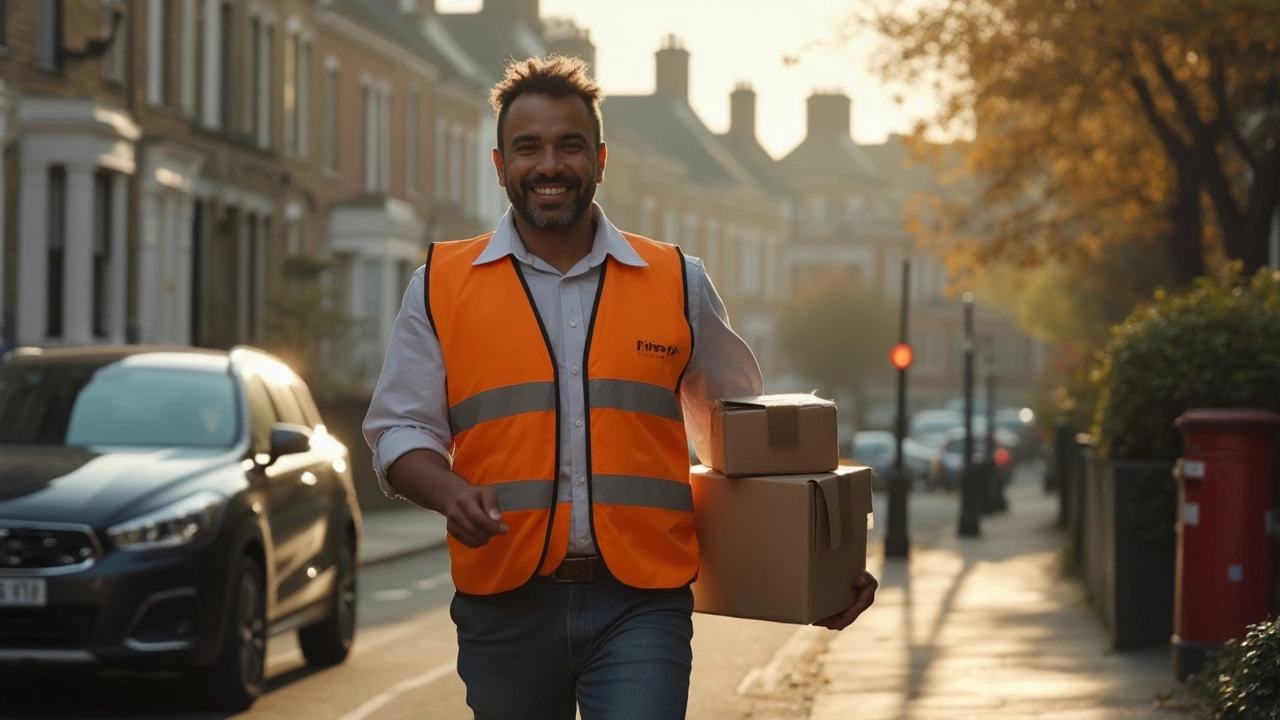Making cash with Amazon Flex looks dead simple: you grab your phone, pick a delivery block, load up, and drop off packages. It’s basically the gig economy’s answer to old-school courier work, but on your own terms. No manager breathing down your neck—just an app telling you where to go. But does that freedom really translate into solid money, or is it a numbers game you can't win?
People see posts all over social media about drivers making £800 or even £900 in a week, and some Americans claiming to hit $1000 easily. Sounds tempting, right? The reality’s a bit more complicated. Location, hours worked, and demand all play massive roles. If you’re thinking about giving Amazon Flex a go, it pays to know what you’re actually signing up for instead of chasing viral TikToks. Let’s break down the facts so you skip the guesswork and get straight to the numbers that matter.
- How Amazon Flex Works
- Crunching the Numbers: Realistic Earnings
- The Best Times and Places to Boost Your Pay
- Hidden Costs Most Drivers Overlook
- Tips to Hit Higher Weekly Payouts
- Is $1000 a Week Sustainable?
How Amazon Flex Works
Amazon Flex is a gig platform where you, as an independent driver, help deliver Amazon packages using your own car. The Amazon Flex app is the control centre for everything: it’s where you pick up work, get directions, and see what you’ll earn. You don’t report to a warehouse boss—once you’ve cleared their quick application process and background check, most people can start delivering within a week or two.
Here’s the gist: you book a "delivery block" in the app, which lasts a few hours (commonly 3 or 4). During your block, you go to a local Amazon depot, load your car with packages, and the app maps your route. You deliver to houses, flats, or sometimes businesses. At the end, scan your last package, and boom—done for that block.
Here’s how it rolls, step by step:
- Download the Amazon Flex app and finish the sign-up with your details and a background check.
- Wait for your account to be activated. This can take days or a couple of weeks depending on your area.
- Once live, watch for available blocks in your region. Hot tip: slots go fast, especially during busy times or bad weather.
- Accept a block, head to your assigned depot, and check in through the app.
- Load up your vehicle with packages—sometimes a full boot, sometimes just a few bags. Size and load depend on the block type.
- The app gives you turn-by-turn delivery instructions. Usually, you get a mix of apartments, row houses, and a dash through city streets or rural roads.
- Scan each parcel at the door, tap delivered, and repeat. If a customer isn’t home, follow the app's instructions for leaving parcels or snapping a proof photo.
- End your block—all your deliveries done, payment credited to your account. Most drivers get paid weekly, straight into the bank.
Let’s clear up one thing about gig and courier services in the UK versus the US: In Liverpool, as in most UK cities, you’re usually on a zero-hour contract, not a regular wage. You’re responsible for your own taxes, fuel, insurance, and the wear on your car. While you have the flexibility to pick your hours, you’re competing with other drivers for the same prime-time slots.
For a quick picture of the basics, check out this snapshot of how a standard four-hour block might look:
| Step | What’s Involved |
|---|---|
| Block booking | Snagging a shift in the app (up to a week in advance, sometimes last minute) |
| Depot arrival | Check-in and load car |
| On the road | Follow the route, drop packages at each stop |
| Finish up | Scan last item, confirm all drops done |
| Payout | Amazon processes payment after block completion |
In short, Amazon Flex offers massive freedom but comes with all the responsibility on you. The more blocks you book (and the smarter your routes), the more you can earn. But before you start dreaming of $1000 weeks, let's keep digging.
Crunching the Numbers: Realistic Earnings
Here’s where things get real with Amazon Flex—your take-home pay depends on a few basics: your city, the hours you grind, how many “blocks” you can snag, and how much time it actually takes to wrap up a route. The official pay rate in the UK usually sits around £13–£15 per hour, while in the US, you’ll often see $18–$25 an hour quoted. But that’s just the headline number. Reality? Sometimes you’ll earn more, sometimes less.
Let’s break it down. If you want to hit $1000 (£800-ish) in a week, you’re probably thinking about working full-time hours. Here’s a quick look at what kind of math you’re juggling:
| Location | Typical Rate (Per Hour) | Hours to $1000 (£800) / week |
|---|---|---|
| US (high demand cities) | $22 | approx. 46 |
| UK (London zone) | £15 | approx. 53 |
In reality, not every hour is billable. You only get paid for delivery blocks, not the time you spend driving to the depot, waiting for packages, or stuck in traffic. Sometimes it takes longer than planned, especially when the app gives you a tricky route or you get lost in city centre chaos.
- Securing enough blocks is the biggest challenge. Popular times, like weekends and evenings, get snapped up by regulars fast. You have to be lightning-quick on the app or have notifications turned on to grab high-earning shifts.
- Factor in cancellations. Sometimes a block will get canceled last minute—no pay, wasted time. It happens more than folks expect.
- Extra income from tips is rare in the UK, but more common in the US. Still, don’t assume you’ll be swimming in bonuses.
Most UK drivers who treat Amazon Flex as a side hustle end up averaging £300–£500 a week, if they get lucky with shift availability. To even approach $1000/£800, you’d need to treat it like a regular job, hustle every single day, and hope things line up in your favour. So yeah, it’s doable—but it’s not at all easy, and you need a dose of luck plus serious commitment.
The Best Times and Places to Boost Your Pay
Getting the most out of Amazon Flex is all about timing and location. Not every shift is created equal, and some blocks give way better earnings than others. If you’re hoping to get close to that $1000 a week goal, you’ve got to be smart about when and where you work.
First up—best times. Demand always spikes around the lunch hour and again in the evenings. On weekdays, most drivers in the UK hit their peak between 4 PM and 9 PM. Weekends are even busier, thanks to everyone expecting packages for Monday or doing last-minute shopping. Prime Now, grocery deliveries, and same-day orders—those blocks usually pay more, and you’ll find them stacked on weekends and right before big holidays.
- Weekday evenings (4pm–9pm)—lots of deliveries, especially in city areas.
- Saturday and Sunday—blocks go fast, but pay can jump by 10–20%.
- Public holidays—higher pay rates and bonus blocks come up.
Now, let's talk locations. City centres like Liverpool, Manchester, and London have more routes but also more competition. Suburbs and dense residential neighborhoods just outside cities are goldmines—less traffic, quick drop-offs, and you can squeeze in extra parcels to your route. Don’t ignore industrial parks or retail areas, either. They can be packed with easy drop points, especially during business hours.
If you have the flexibility, check the app at odd hours. Early mornings and late nights sometimes pop up unclaimed blocks with surge pay. And if you want to see just how much rates can jump, here’s a quick snapshot from January 2025 showing standard versus surge block pay in Liverpool:
| Time Slot | Standard Block (£/hour) | Surge Block (£/hour) |
|---|---|---|
| Weekday (2pm–4pm) | £13.50 | £15.80 |
| Evening (5pm–9pm) | £14.00 | £17.20 |
| Weekend (11am–7pm) | £15.00 | £18.00 |
If you keep an eye on these high pays and focus on popular times, you’ll snag the higher earnings. It’s not just about working hard—it’s about working smart and knowing when to pounce.

Hidden Costs Most Drivers Overlook
On the surface, delivering with Amazon Flex looks like an easy way to earn. What often trips up new drivers is not what they make, but what they spend just to keep going. It’s not just petrol. You’ve got a string of expenses most people ignore when they see those big paydays on social media.
The main cost is fuel, and let’s be honest, it gets worse the more you drive. In the UK, fuel prices hover around £1.50 per litre (as of April 2025), and delivery routes are rarely as tight as the app makes them look. Some days, you’ll clock 60–80 miles in a single go. That can easily burn £15 or more daily, depending on your car’s efficiency.
But that’s just the start. Put your car through daily delivery work and you’ll notice tyres wear down faster, brakes need swapping more often, and oil changes creep up quicker. Your MOT and regular service costs will rise. Skipping these? You risk breakdowns that can wipe out an entire week’s pay. Insurance is another big one—if you’re only running on personal insurance and something happens, you could be left stranded. Amazon Flex actually requires you get ‘business use’ insurance, which is pricier than regular cover for most cars.
Here’s a breakdown of the most common hidden costs for Amazon Flex and other gig economy drivers:
- Petrol or diesel – average £15–£25 per full day’s shift
- Increased wear/tear on your car (tyres, brakes, servicing)
- Extra MOTs or servicing checks
- Higher insurance premiums for business use cover
- Parking charges and the occasional fine
- Phone data costs (the app eats data, especially if you use maps)
- Snack runs—because stopping for petrol always means grabbing something else
If you want a clearer picture, here’s a simple comparison of a week’s basic running costs for a full-time Amazon Flex driver in Liverpool:
| Expense | Average Cost (per week) |
|---|---|
| Fuel | £80 |
| Car Maintenance Fund | £20 |
| Insurance Top-Up | £12 |
| Parking/Fines | £10 |
| Phone/Data | £5 |
| Snacks/Coffee | £8 |
| Total | £135 |
Shave that off your weekly earnings, and suddenly, that $1000 a week dream looks a bit smaller. So when you see someone mention big money doing courier services, remember—they’re not showing you the full picture.
Tips to Hit Higher Weekly Payouts
If you’re hoping to break that $1000 weekly ceiling with Amazon Flex, you need more than just luck. You need a plan. Here’s what most high-earning drivers swear by:
- Stack Your Blocks: Instead of waiting for one-off shifts, check the app often and book back-to-back blocks during peak demand. It helps to refresh the app after each completed delivery—you’ll often see more shifts pop up, especially late at night or early mornings.
- Pick Prime Delivery Times: Weekends, holidays, and the run-up to big online sales spike the orders. Sort your hours around these peak times. If you're in a busy city, you’ll see more courier services gigs posted during lunch or right after work hours.
- Work Amazon Fresh and Whole Foods Blocks: These aren’t just about parcels; groceries pay better per hour, especially in high-density areas. They’re heavier, sure, but your hourly rate can go up by a few quid.
- Track Miles and Expenses: Use an app or a spreadsheet to log your fuel, car wear, and parking. High earners know exactly what they’re spending so they can see what’s working and what isn’t. Otherwise, you might think you’re smashing it, only to find most of it’s gobbled up by costs.
- Park Smart and Avoid Traffic: Knowing the city helps you shave down delivery times. Skip the city centre at rush hour unless the block pay is worth the hassle. Shortcuts, smart parking, and avoiding congestion charge zones keep your profit up.
- Grab Last-Minute Blocks: Flex will sometimes bump up pay when they need urgent drivers, adding ‘incentives’. This can sling an extra £10–£20 per block, especially around holidays or during driver shortages.
Here’s a breakdown from real driver reports based around Liverpool, to give you an idea of where those high weekly payouts come from. These are average “block” earnings, but rates jump and dip depending on the city and demand:
| Block Type | Avg. Duration (hrs) | Typical Pay (£) |
|---|---|---|
| Standard Parcel | 3.5 | £40–£55 |
| Prime Now | 2 | £28–£38 |
| Amazon Fresh/Whole Foods | 3 | £45–£70 |
| Same Day | 4 | £62–£80 |
Combine these practical moves with a reliable car and a pinch of hustle, and your shot at hitting that magic number gets a lot more real. Just keep in mind, the gig economy is a rollercoaster—one good week doesn't mean it'll always be easy.
Is $1000 a Week Sustainable?
Let’s get real—grabbing £800 to £1000 a week with Amazon Flex sounds awesome, but keeping it up week in, week out is tough for most drivers. In big cities like London or Manchester, drivers can sometimes hit these numbers if there’s high demand and they go all-in with long hours. In Liverpool, I’ve seen mates take home over £700 in one of those crazy busy holiday weeks. But on average? It’s usually less, especially if you’re not putting in 40 or more hours.
Consistency is where things get tricky. Courier services like Amazon Flex are totally at the mercy of local demand. Some weeks you’ll be drowning in block offers; other times, it’s tumbleweeds. Plus, Amazon limits how many hours you can work (usually about 20-40 per week), and there’s no guarantee you’ll snag all the best-paying blocks. Even die-hard drivers often have to refresh the app nonstop or take late-night shifts just to scrape together enough gigs.
Here’s something people forget: your real pay isn’t just what lands in your account. You have petrol, car wear and tear, insurance, snacks on the go, and self-employment taxes. Take a look at how your £££ can get chipped away:
| Estimated Weekly Gross | Fuel/Expenses | Net Earnings |
|---|---|---|
| £800 | £100-£150 | £650-£700 |
| £1000 | £150-£200 | £800-£850 |
To keep earnings high, you need to drive smart. Top earners know the best delivery zones, pile up quick routes, and work weekends when the money’s better. There’s also burnout—working over 10 hours a day, 6 or 7 days at a stretch, isn’t fun for long.
The bottom line? If you live in an area with fierce demand, you hustle hard, and you don’t mind the grind, making up to $1000 (or just under £800) a week is possible—but it’s rare to keep it going every single week. For most people, earning potential with Amazon Flex lands somewhere lower, unless you’re doing it during peak season or you treat it like a full-time mission.


